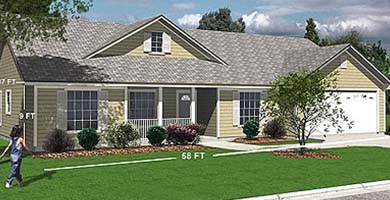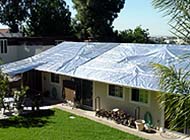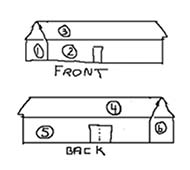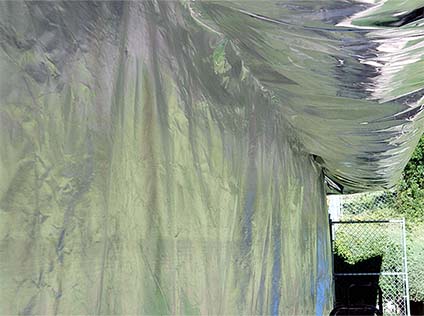



First, Fire Shields reflect up to 96% of the fires radiant heat and 92% of the convective heat away from your home helping to prevent preheating. A major cause of house ignition is when radiant heat preheats the wood to its flash point, about 585°F. Although wood can burn about 400°F it can burst into flames without flame contact at its flash point. Radiant heat also passes through unprotected windows and preheats curtains, furniture, and carpet to combustion and the home burns from the inside out.
Second, Fire Shields provide a fire resistant, slick surface that allows firebrands or burning embers to land and slide off your roof or extinguish safely. They also eliminate sharp angles on your roof that can catch and trap embers allowing them to burn and eventually ignite your roof. Curved Spanish tile roofs, like those used in the Southwest, can become ember-collectors, actually trapping burning embers inside, if they are not sealed.
Third, Fire Shields provide a fire resistant layer between your home and radiant heat, flames, and firebrands. By using the water saturation method, simply laying a sprinkler hose at the top of your roof then covering it with fire shields, the shields prevent evaporation and maintain a wet environment under the shields dramatically improving your survival chances. If the heat gets very severe the moisture will turn to steam, reducing oxygen, wetting fuel (your roof or walls), and dissipates the heat.
And finally, in the worst case scenarios anchored Fire Shields will deny the fire oxygen that it needs to burn. In some cases after long extended exposure to intense flame or heat some smoldering or charring may occur under the shields. Firefighters can easily extinguish this when they come back after the fire has burned through. Better to replace a section of roof than lose your entire home.

This varies but is fairly easy to figure out. We recommend drawing a simple box diagram of the structure. Then look at each side as a panel. Example: Front 30’ wide 10’ tall, 300 Sq Ft. Right Side 40’ long 10’ high, 400 Sq Ft. Add up all the panel sides and the roof if needed, and multiply by 15 to 20% for overlap and good measure. Firezat rolls have 1,000 Sq Ft per roll, so divide your number by 1,000 and that is how many rolls you need to protect against firebrands and burning debris.
Zone 0 Critical Areas you know will burn. Move or wrap anything that will ignite easy. Wood piles, fences, shake roofs, decks, sheds, single pane windows, anything combustible, exposed, and dry.
Zone 1 The roof and eaves. If your roof is Class A rated it is probably safe, but wrap facia boards and especially eaves. Eaves are critical as rising heat from burning debris against the house will be trapped and ignition is fast.
Zone 2 The walls. The walls should be wrapped, burning debris blown by the fire can be trapped by the house and the heat will concentrate in the eaves and trigger ignition.
Zone 3 Decks. If decks are near the ground close off access underneath by blocking with non-combustible material. Wrap the underneath decks if off the ground due to rising heat as mentioned above.
This is one time where more is better so your measurements do not have to be exact.
When measuring or estimating your roof come from the highest point down to the gutter and include enough to cover under the eave and down the wall a foot or so. Eaves are heat traps and critical areas to protect.

To Cover just the roof using the example above = 1800 Sq Ft. times 20% (for overlaps)= 360

It might be helpful to draw a basic diagram of your home and number the walls.
Total Area 3,426 Sq Ft to cover the main panels. We then add 20% for overlaps.

To Cover the entire home 3426 Sq Ft. times 20% = 685


Firezat Fire Shields have been used by the United States Forest Service to protect historical buildings, high value critical structures, bridges, lookouts, homes and other “Can’t Lose” Items. Our Fire Shields are easy to handle, deploy quickly, and designed for areas such as roofs, homes, buildings, vehicles, business inventories and equipment.
Firezat Fire Shields are delivered and stored as a roll approximately 6” X 6” X 60”. They can be stored for extended periods of time and will not support mold or mildew. They are resistant to most acids, alkalis & solvents with the exception of hydrofluoric acid. If the home or business is sold they can be passed on to the new owners just like a burglar alarm system or you can take them with you.
Firezat makes no claims or statements, or offers any assurance or assurances, guarantees, promises, either direct or implied, as to the effectiveness or suitability of its products to protect any property or possessions from fire damage or any other calamity whether anticipated or foreseen. Due to the extreme conditions of high heat, high winds, low humidity, and unpredictability associated with all fires it is impossible to make such guarantees. Before using, the user agrees to assume all risks and liabilities in connection with deployment, application, use and/or storage of Firezat Fire Shields. Sellers and manufacturers only obligation shall be to replace any unused Fire Shields found to be defective within one year from the date of purchase. Please see Disclaimer for complete disclosure.
